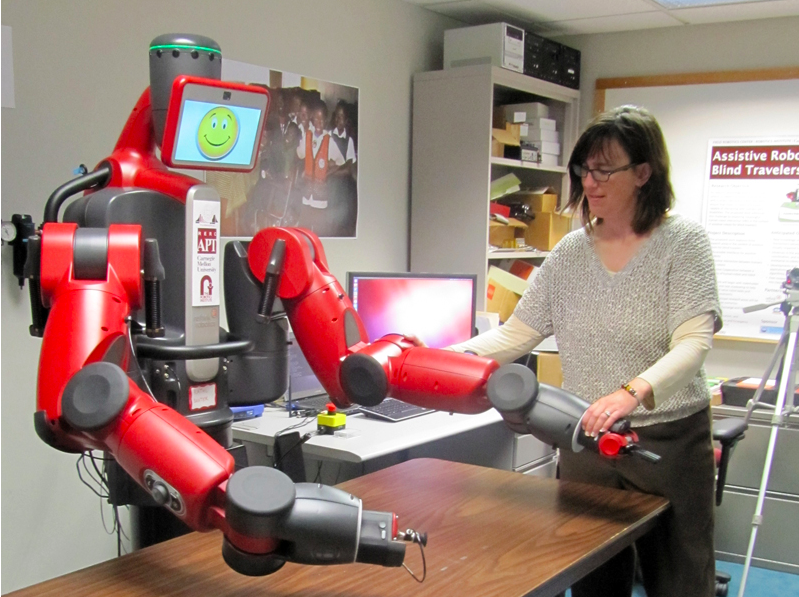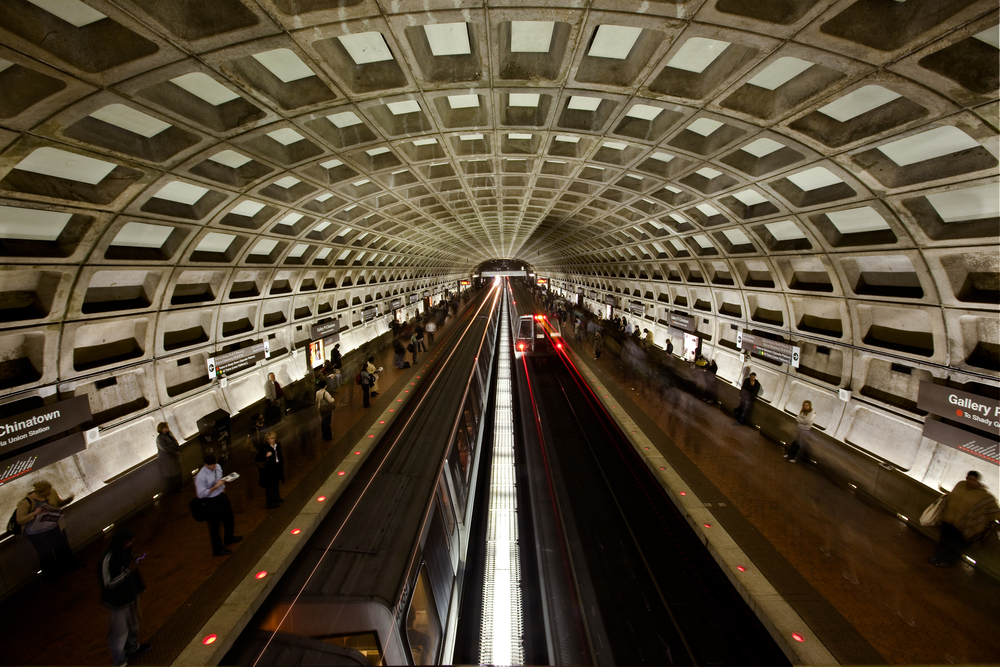Connecting state and local government leaders
An assistive robotics project is exploring how advanced technology could make it easier for people with visual impairments to navigate cities.
A blind person is traveling on the subway. The train they’re riding on pulls into a stop, the doors open and the person exits. Waiting there on the platform, to help guide them through the station, is a robot.
“Making a robot do that, there are some challenges, but it’s not as challenging as it used to be,” said Aaron Steinfeld after describing the scenario involving the guide-bot during a recent interview. Steinfeld is an associate research professor at Carnegie Mellon University’s Robotics Institute in Pittsburgh, where he specializes in human-robot interaction.
He and others at the university are working on a project that aims to incorporate robots, smartphones, mobile applications and crowdsourced information into a system that can help blind people navigate complicated and unfamiliar urban environments, such as transit stations.
“If you have a disability, it can be rather difficult to just get up and go somewhere because of the planning and the information that you need at your disposal,” Steinfeld said. “That’s where information technology and assistive robot systems could really shine.”
Though it is not the only challenge blind people and others with limited vision face when moving around in big cities, navigating a subway system can among the toughest, especially for those who don't do it often. The robotics research taking place at Carnegie Mellon is just one example of how technologists, nonprofits and transit agencies are looking for ways to make that experience easier.
Before Bots, Beacons
While the guide-bot research is still in its early stages, a different effort with a similar goal is unfolding in Washington, D.C. If it goes according to plan, there could be new devices to help blind people find their way through Metrorail stations before the end of summer.
A nonprofit group, Columbia Lighthouse for the Blind , or CLB, is pushing that project forward. It involves installing guidance beacons in five to seven Metrorail stations. The beacons could be in place in the Gallery Place-Chinatown and Metro Center stations by July or August, and in three to five more stops by year’s end, according to Brandon Cox, the organization’s senior director of rehabilitation and education services.
Already in use in the London Underground and San Francisco International Airport , the beacons send information to a person’s bluetooth enabled mobile phone about their location and surroundings as they move through a space.
“Basically you get within 20 feet of a beacon and it will either send you a text message, or an audio message, whatever you decide,” Cox said. “It tells you whatever you’re near."
The beacons will be positioned along routes described in audio files posted in an online database. So, ultimately, a person should be able to walk through a Metro station, listening to a route description on their smartphone, while getting an alert that they’ve reached a certain point as they pass each beacon.
According to 2010 U.S. Census Bureau figures , two million Americans were blind or unable to see and 8.1 million had difficulty seeing newsprint even when wearing glasses or contacts.
There’s no readily available data for how many of these people ride subway trains each year. But Chris Danielsen, public relations director for the National Federation of the Blind , pointed out that mass transportation can be critical for the blind because they cannot drive.
“Public transit is obviously extremely important to blind people where it’s available,” he said.
“We don’t always demand that the most cutting-edge technology be used,” Danielsen added. “But we do demand a certain level of accessibility.”
‘It’s Overwhelming at Times’
Brenda Loughrey lost her vision at the age of six in an accident.
She now works with the Pathfinder School in Bethel Park, Pennsylvania, teaching visually impaired school-age students how to use technology, such as keyboards, digital books, wayfinders and global positioning systems.
Though she is not a frequent subway rider, Loughrey has traveled widely for her work.
“All my adult travel years, I’ve been totally blind,” she said. “And I’ve traveled a lot. My first dog and I were in 38 states, many cities in some of those states, in one year.”
Referring to the instances when she has used subways, Loughrey said: “It’s overwhelming at times.”
“You’re down in there, and everybody’s moving different directions, and you’re trying to stop somebody who’s in a hurry to ask them for directions,” she explained. Loughrey noted that noise and the lack of cell phone reception can further complicate attempts to get information.
While she is open to new technology to help blind people travel, Loughrey stressed that, on its own, it is not a panacea.
“We have to have so many listening skills, you have to have that cane protecting you, or know how to pay attention to your dog and take their signals,” Loughrey said. “Even following a robot, if that comes to be, if you don’t have the ability to watch out for things on the floor, or people in front of you, you’re not going to be able to use it.”
Steinfeld explained that the Carnegie Mellon team is not trying to build technology that encourages over-dependence on robots. “Ideally you’d like these kinds of systems to help people learn a new route, get through an unfamiliar place that they may only go once in their life,” he said. “For example, if they’re visiting someone or traveling.”
A systems-based approach is central to the work taking place at Carnegie Mellon. The researchers there are not only exploring the idea of a robot that can act like a guide dog. In fact, there’s another robot that they’re experimenting with first, which has arms, and cameras in its hands, and is envisioned as station agent of sorts that could assist blind travelers.

Called Baxter , the “humanoid” robot is commercially available. With two arms and a computer screen for a face, it is designed for applications like machine-tending and packaging, and can retail for $25,000 . Steinfeld said the research team is looking at ways it could prove useful for helping a blind person identify items they are holding, or tracing directions for how to get through a space onto the person’s hand to reinforce information communicated verbally.
Smartphones and mobile applications are also important components of the research.
For instance, an expert in blind navigation, or another trusted source, might mark-up a path through a transit station using a smartphone app. This information would be shared not only with blind and visually impaired app-users to help them get through the station, but also with the robots, who could factor it into the guidance they might offer.
The idea, Steinfeld said, is to design a system of robots and smartphone technology that can provide “deep local knowledge of what’s going on in the station and in the surrounding areas around the building, so that you’re getting appropriate information for the time and place.”
“You can do some really interesting combinations when you take a systems level approach,” he said. “You don’t want to have just a freestanding robot, or just a smartphone.”
The principal investigator on the project is another associate research professor at Carnegie Mellon’s Robotics Institute, M Bernardine Dias .
Dias has also headed-up a project called “ NavPal ,” which seeks to offer a number of tools to help blind and visually impaired people navigate in urban environments. These include a mobile app that offers audio directions, an online tool that allows for pre-planning of indoor routes, and software for creating and editing maps of buildings.
A $978,571 National Science Foundation grant is funding the assistive robotics research. It is currently scheduled to last through 2019 and will also look at how robots can assist blind and visually impaired people during emergency evacuations from buildings.
The beacon project that is getting underway in Washington, D.C., will build on the Columbia Lighthouse for the Blind’s earlier work involving the city’s Metrorail system.
Last year, in collaboration with a St. Paul, Minnesota-based company, ClickAndGo Wayfinding Maps , the group launched a website that provides 110 sets of audio directions to guide people between the Gallery Place-Chinatown Metrorail station and nearby locations. The site also features audio descriptions of the layout and entrances of other Metro stations as well.

The directions and descriptions can be downloaded as audio files, or accessed over the phone through a dial-in service.
People can also get the directions through the ClickAndGo Wayfinding mobile application , which became available earlier this year. The goal is for the app to interact with the beacons once they are installed, providing additional information as a person moves through a station.
With Innovation, There’s Some Skepticism, Too
CLB’s Cox is not quick to embrace the latest gadgets and apps designed to help the blind.
“I’m very skeptical of any kind of blind tech,” he said.
What he likes about the beacons, and the technology that ClickAndGo provides, is that they’re not overwhelming and are also free to use. “We also like the fact that it doesn’t teach a person how to travel, it’s basically just a map,” he said.
If the beacons prove to be successful after they are installed in the initial five to seven “demonstration” stations, Cox said Columbia Lighthouse will press the Washington Metropolitan Area Transit Authority to put the devices in all 91 of the system’s Metrorail stops.
The Metropolitan Washington Council of Governments approved a total of $250,000 for the beacon project. Of that amount, $200,000 is from a Federal Transit Administration grant.
The money will also pay for route and stop descriptions, and high-resolution maps to aid people with low vision, for the stops where the beacons are installed. The beacons themselves tend to cost about $35 each and run on lithium batteries, according to Cox.
“It’s not going to be this huge investment into physical infrastructure,” he said.
While she was not referring to the work Columbia Lighthouse for the Blind is doing, Loughrey, the specialist for the Pathfinder School in Pennsylvania, did say that it would be useful to have detailed audio descriptions online about facilities like airports and major subway stations.
But she also acknowledged that a Baxter-style robot in a station could be useful as well, because there’s not always time to do research on a facility beforehand.
As for the guide-bot, she said: “That would be pretty cool.”
But Loughrey also highlighted a more fundamental problem that blind people encounter when navigating cities, one that new technology may not necessarily solve.
“The inconsistency, there’s no standard,” she said, noting that everything from floor textures demarcating dangerous areas, to audible signals at crosswalks vary from town to town.
“A lot of people have very interesting ideas about how to make things more accessible, and some of them work beautifully, but if you don’t live there, and aren’t familiar with them, they aren’t very helpful,” Loughrey continued. “It’s a challenge, and almost a game, traveling right now, because you do have to really prepare, and you have to think it through.”
“You have to have really good travel skills,” she added. “No matter how good the technology gets.”

NEXT STORY: Virtualization ends decade-long refresh cycle




